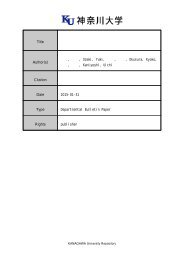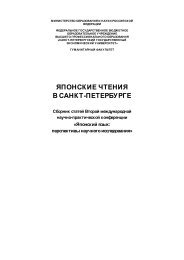to Learners with Special Educational Needs
e-textbook SEN
e-textbook SEN
You also want an ePaper? Increase the reach of your titles
YUMPU automatically turns print PDFs into web optimized ePapers that Google loves.
Pokrivčáková, S. et al. (2015). Teaching Foreign Languages <strong>to</strong> <strong>Learners</strong> <strong>with</strong> <strong>Special</strong> <strong>Educational</strong> <strong>Needs</strong>:<br />
e-textbook for foreign language teachers. Nitra: Constantine the Philosopher University. 128 p.<br />
ISBN 978-80-558-0941-0<br />
2012). However, it is not rare for gifted children <strong>to</strong> have learning difficulties, social, emotional<br />
and behavioural disturbance, or disorders such as Asperger syndrome or ADHD.<br />
These children are called twice exceptional and they are gifted and have disabilities at the same<br />
time (Silverman, 2012; Trail, 2010). Gifted children <strong>with</strong> learning difficulties may be often<br />
viewed as underachievers, or in a better case as average, because they use compensating<br />
strategies <strong>to</strong> hide their difficulties. In such cases, their abilities nor disabilities are recognized.<br />
Strategies for teaching children <strong>with</strong> learning difficulties, gifted children and gifted children <strong>with</strong><br />
learning difficulties need challenges that can be built on the children´s interests and strengths<br />
and they require more support <strong>to</strong> overcome difficulties. The following strategies should be used<br />
(Bevan-Brown & Taylor, 2008):<br />
explicit teaching - thinking aloud, visualising, self-questioning,<br />
compensa<strong>to</strong>ry strategies – computer spellchecks, dictation recorders, reader/writer<br />
assistance, other aids,<br />
encouraging <strong>to</strong> develop coping strategies – working <strong>with</strong> a men<strong>to</strong>r, using relaxation<br />
techniques, finding out how others cope, developing excapes such as music, painting<br />
teaching multisensory approaches - looking for patterns in reading and spelling, making<br />
pictures of words and phrases, working <strong>with</strong> CDs, visualising, tracing, etc.<br />
encouraging reasonable expectations – doing less, giving more time, doing only what is<br />
important, prioritising things, etc.<br />
Model activities<br />
Two tips for an English class lesson developing fluency, creativity, originality and flexibility<br />
are given. Both activities are recommended for pupils <strong>to</strong> work in small groups. When taught in a<br />
regular class, there should be similar representation of pupils in each group <strong>with</strong> a gifted child in<br />
each group. In segregated classes, gifted children could work both, individually or in a group.<br />
Both activities are taken from online magazines for children (authentic print materials), which<br />
can bring reality and real language <strong>to</strong> the classroom.<br />
Finishing a s<strong>to</strong>ry<br />
The first example is a fiction s<strong>to</strong>ry from a Creative Kids magazine. The activity is suitable for a<br />
lower secondary grade gifted pupils (age 13-15), whose English is on A2 level. The title and a<br />
beginning of a s<strong>to</strong>ry is given. Pupils work in groups and create a s<strong>to</strong>ry based on given starting<br />
sentences. Pupils should be given sufficient time <strong>to</strong> write the s<strong>to</strong>ry. The next lesson they should<br />
read their s<strong>to</strong>ries in front of the class. At the end the teacher presents them the full s<strong>to</strong>ry that<br />
was written in the magazine. They discuss all the s<strong>to</strong>ries and vote for the best one. Further<br />
suggestions can be dramatizing and performing the best s<strong>to</strong>ry.<br />
The Monster in the Closet<br />
Meet Jimmy. Jimmy just turned off his lights and tried <strong>to</strong> go <strong>to</strong> sleep. He fell asleep after about 20<br />
minutes. When he woke up, it was about 1:30 in the morning. Something happened that night.<br />
Something Jimmy would never forget. Something . . . well, you'll see what I mean . . .<br />
(Source: http://www.ckmagazine.org/prose/2015/2/19/the-monster-in-the-closet.html)<br />
120






